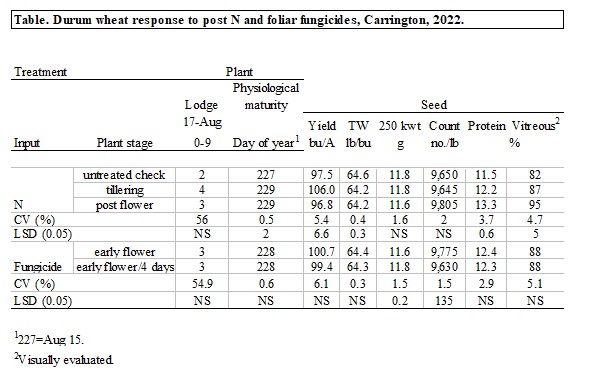The irrigated field trial was conducted for a second year at the NDSU Carrington Research Extension Center with support from the ND Wheat Commission. Study objective is to examine durum seed yield and quality response, primarily seed protein and vitreous kernels (hard count), to intensive management with application of post-emergence applied nitrogen (N) and foliar fungicides. Experimental design was a randomized complete block with factorial arrangement and four replicates. Urea was preplant applied at 116 lb/A N across trial on May 12 and incorporated. ‘ND-Riveland‘ was seeded at 1.4 million PLS/A on May 19 on ground with a previous crop (2021) of winter rye. Soil was conventional-tilled Heimdal-Emrick loam with 24 lb/A N, 25 ppm P, 208 ppm K, 3.0% organic matter, 8.0 pH (0-6 inch depth) and 0.2 mmho/cm soluble salts (0-6 inch depth). Urea was applied at 30 lb/A N for early season top-dress N treatments (3 and 4) on June 12 to 3- to 4-leaf stage plants and incorporated with 1.2 inches of rain on June 13. Fungicides were applied with a CO2-hand-boom plot sprayer delivering 14 gal/A at 35 psi through TJ60 8002EVS nozzles. Miravis Ace at 13.7 fl oz/A plus Induce (NIS) at 0.125% v/v was applied across trial on July 14 with 65 F, 86% RH and 10 mph wind to early flower stage plants. Prosaro at 8.2 fl oz/A plus Induce at 0.125% V/V was sequentially applied for treatments 2, 4 and 6 on July 18 with 88 F, 72% RH and 2 mph wind to late-flower stage plants. UAN (liquid 28-0-0) was applied at 10 gpa (30 lb/A N) plus 10 gpa water at 35 psi through TJ XR 80015VS nozzles for treatments 5 and 6 on July 22 with 78 F, 53% RH and 9 mph wind to early post-flower stage plants. Rainfall plus irrigation (inches): May 18-31=2.6; June=2.5; July=4.3; August 1-26=4.6; and total period water=14.0. Trial was harvested with a plot combine on August 26.
Wheat stand at 2- to 3-leaf stage on June 9 averaged 1.43 million plants/A. Flag leaf disease and Fusarium head blight (scab) were essentially absent from the trial and were not recorded. Visually estimated flag leaf necrosis present one week after post-flower stage application of N ranged from 10-20%.
Averaged across fungicide treatments, post N application tended to increase plant lodge and extended maturity two days compared to the untreated check (Table). Seed yield increased 9% with N application at tillering stage compared to the untreated check. Seed protein content increased 1.8 and 0.7 percentage points with N application at post flower and tillering stages, respectively, compared to the untreated check. Vitreous kernels increased 13 and 5 percentage points with N application at post flower and tillering stages, respectively, compared to the untreated check.
Averaged across N treatments, fungicides only impacted seed weight and count. Sequentially applied fungicide slightly increased seed weight and size compared to the sole application at early flower stage.
No statistical significance occurred with the two post-application factors (N and fungicides) for the measured agronomic elements.

